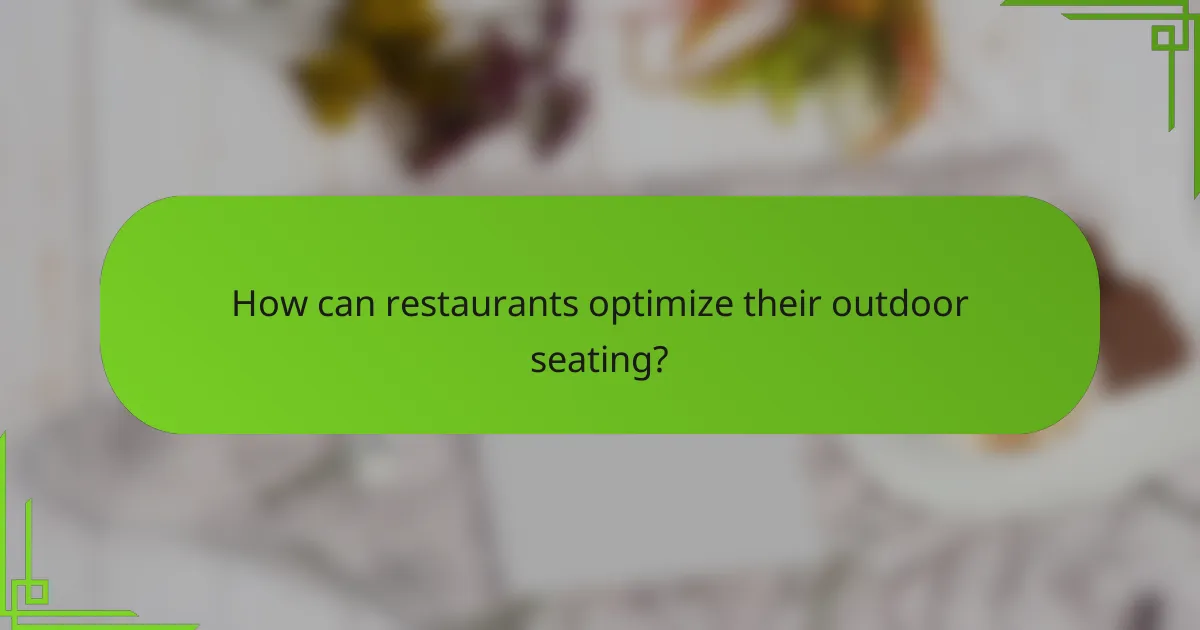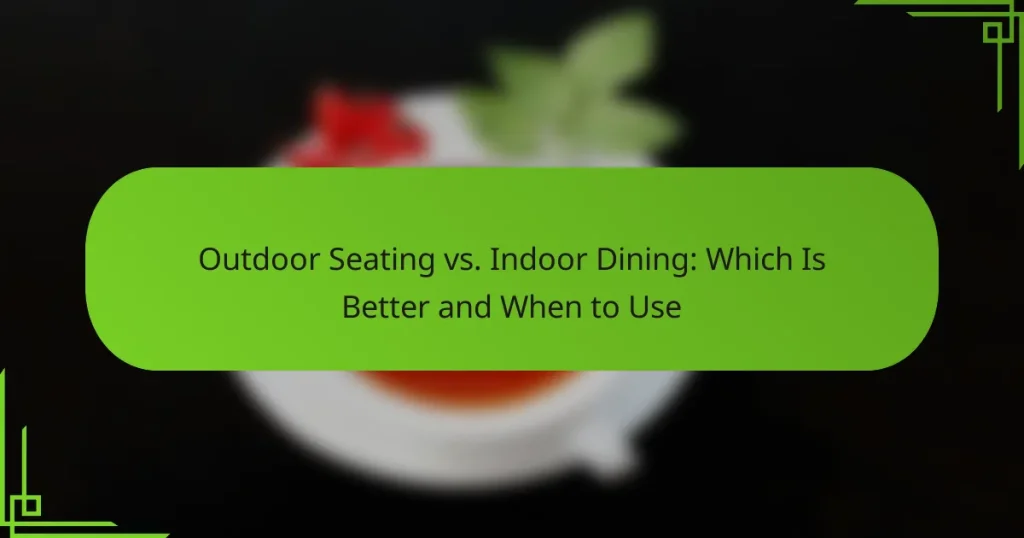When deciding between outdoor seating and indoor dining, various factors come into play, including weather, ambiance, and safety. Outdoor dining can provide a vibrant atmosphere and fresh air, making it ideal for pleasant days, while indoor dining offers climate control and privacy for a more intimate experience. Understanding the benefits of each option can help you choose the best setting for your meal, depending on the occasion and your preferences.

When should you choose outdoor seating in Los Angeles?
Choosing outdoor seating in Los Angeles is ideal when the weather is pleasant, and you want to enjoy a lively atmosphere. Outdoor dining can enhance your experience, especially in the city’s vibrant neighborhoods, where the environment adds to the enjoyment of your meal.
Ideal weather conditions
Los Angeles is known for its mild climate, making outdoor seating a great option most of the year. Ideal conditions typically include temperatures ranging from the mid-60s to mid-80s Fahrenheit, with low humidity and clear skies. Be mindful of seasonal variations, as summer can bring higher temperatures, while winter evenings might require a light jacket.
Social atmosphere benefits
Outdoor seating often fosters a more social and relaxed atmosphere compared to indoor dining. The open air encourages conversation and interaction, making it a popular choice for gatherings with friends or family. Additionally, the vibrant street life in many LA neighborhoods can enhance the dining experience with sights and sounds that create a lively backdrop.
Space for larger groups
Outdoor areas often provide more space, making them suitable for larger groups. Many restaurants in Los Angeles feature patios or gardens that can accommodate parties of various sizes, which is particularly beneficial for celebrations or casual get-togethers. When planning a gathering, consider reserving an outdoor space in advance to ensure availability.
Unique dining experiences
Dining outdoors in Los Angeles can offer unique experiences that indoor settings may lack. From rooftop views to beachfront locations, outdoor seating allows you to enjoy the city’s diverse landscapes while savoring your meal. Look for restaurants that host special events or themed nights outdoors to enhance your dining adventure.

What are the advantages of indoor dining?
Indoor dining offers several advantages, including climate control, reduced noise, and enhanced privacy. These factors can significantly improve the dining experience, making it more comfortable and enjoyable for patrons.
Climate control and comfort
Indoor dining provides a stable environment, allowing diners to enjoy their meals without the influence of weather conditions. Air conditioning or heating systems maintain a comfortable temperature, which is particularly beneficial during extreme weather, such as hot summers or cold winters.
Additionally, indoor spaces can be designed with comfortable seating and decor that enhances the overall dining experience. Restaurants often invest in creating a cozy atmosphere, which can encourage longer visits and increased customer satisfaction.
Reduced noise and distractions
Indoor dining typically features lower noise levels compared to outdoor settings, where wind, traffic, and other environmental sounds can disrupt conversations. This quieter environment allows diners to focus on their meals and engage in meaningful discussions.
Moreover, many restaurants utilize sound-absorbing materials to further minimize noise, creating a more pleasant atmosphere. This is especially important for business meetings or intimate gatherings where communication is key.
Enhanced privacy for diners
Indoor dining often provides greater privacy than outdoor options, which can be crucial for special occasions or confidential meetings. Enclosed spaces allow diners to feel more secure and less exposed to passersby.
Restaurants may also offer private dining rooms or booths, catering to those who prefer a more secluded experience. This added privacy can enhance the enjoyment of a meal, making it more personal and memorable.

How do outdoor seating and indoor dining compare in terms of safety?
Outdoor seating generally offers a safer dining experience compared to indoor dining, especially during health crises. Fresh air circulation reduces the risk of airborne illnesses, while indoor spaces may require stricter safety measures to ensure guest protection.
Health guidelines for outdoor dining
When dining outdoors, it’s essential to follow local health guidelines, which often include maintaining physical distance between tables and ensuring proper sanitation of surfaces. Many regions recommend using outdoor heaters or canopies to enhance comfort while adhering to safety protocols.
Additionally, patrons should consider the weather conditions, as extreme temperatures can affect the dining experience. It’s advisable to check local advisories for any specific regulations regarding outdoor dining setups.
Indoor dining safety measures
Indoor dining safety measures typically involve capacity limits, enhanced ventilation, and mandatory mask-wearing when not eating or drinking. Establishments may also implement contactless payment options and regular cleaning protocols to minimize risks.
Restaurants should clearly communicate their safety measures to patrons, including any specific guidelines they follow. Guests can help by adhering to these rules, such as maintaining distance from others and following staff instructions for a safer dining experience.

What factors influence the choice between outdoor and indoor dining?
The choice between outdoor and indoor dining is influenced by various factors, including customer preferences, the restaurant’s ambiance, and seasonal conditions. Understanding these elements can help restaurants optimize their seating arrangements to enhance customer satisfaction and operational efficiency.
Customer preferences and demographics
Customer preferences play a significant role in deciding between outdoor and indoor dining. Younger diners may prefer outdoor seating for a vibrant atmosphere, while older patrons might opt for the comfort and climate control of indoor spaces. Additionally, demographic factors such as family size and special occasions can sway preferences; families with children often favor outdoor areas for more space and play opportunities.
To cater to diverse preferences, restaurants should consider offering a mix of both seating options. Surveys or feedback forms can help gauge customer desires, allowing establishments to adjust their offerings accordingly.
Restaurant ambiance and theme
The ambiance and theme of a restaurant heavily influence the choice between outdoor and indoor dining. An establishment with a rustic or beach-themed decor may benefit from outdoor seating that complements its aesthetic. Conversely, a fine dining restaurant might prioritize an elegant indoor setting to enhance the overall dining experience.
Creating a cohesive theme can attract customers who are looking for a specific atmosphere. For example, a café with a garden theme could enhance its outdoor space with plants and comfortable seating, making it a desirable spot for relaxation.
Seasonal considerations
Seasonal factors are crucial when deciding on outdoor versus indoor dining. In warmer months, outdoor seating can attract more customers looking to enjoy pleasant weather, while colder seasons may necessitate a focus on indoor dining to provide comfort and warmth. Restaurants should monitor local climate patterns to anticipate shifts in customer preferences.
To maximize seating capacity year-round, consider implementing features like outdoor heaters or canopies for cooler months. Additionally, promoting seasonal menus that highlight fresh, local ingredients can entice diners to choose outdoor seating in favorable weather conditions.

How does location affect outdoor seating availability?
Location significantly impacts outdoor seating availability, as factors like urban density and local regulations dictate how much space can be allocated for outdoor dining. In cities, space is often limited, while suburban areas may offer more flexibility for outdoor setups.
Urban vs. suburban settings
In urban settings, outdoor seating is often constrained by space limitations, requiring restaurants to maximize small areas, such as sidewalks or rooftops. This can lead to creative solutions like foldable furniture or shared spaces with neighboring businesses.
Conversely, suburban areas typically have more land available, allowing for larger outdoor seating arrangements. Restaurants in these regions can often create expansive patios or gardens, enhancing the dining experience with more room for guests.
Local regulations and permits
Local regulations play a crucial role in determining outdoor seating availability. Many cities require permits for outdoor dining, which can involve zoning laws, safety codes, and health regulations. Understanding these requirements is essential for compliance and successful operation.
In some areas, seasonal permits may be necessary, limiting outdoor seating to warmer months. Restaurants should check with local authorities to ensure they are following the correct procedures and to avoid fines or disruptions to their service.

What are the cost implications of outdoor seating versus indoor dining?
Outdoor seating can significantly impact costs compared to indoor dining, influencing both setup and ongoing expenses. While outdoor areas may require additional investment for furniture and weather protection, they can also enhance revenue potential through increased customer capacity.
Setup and maintenance costs
Setting up outdoor seating typically involves higher initial costs due to the need for weather-resistant furniture and possibly additional infrastructure like awnings or heaters. Maintenance costs can also rise, as outdoor areas require regular upkeep to ensure cleanliness and comfort.
In contrast, indoor dining spaces generally have lower setup costs since they utilize existing structures. However, they may incur higher utility expenses, particularly for heating and cooling, which can add to overall maintenance costs.
Potential revenue from outdoor dining
Outdoor dining can boost revenue by attracting more customers, especially in pleasant weather. Restaurants with outdoor seating often see increased patronage during peak seasons, leading to higher sales volumes.
Moreover, outdoor spaces can allow for unique dining experiences, such as events or themed nights, which can further enhance profitability. However, it’s essential to consider local regulations regarding outdoor dining, as permits and compliance can affect overall costs and revenue potential.

How can restaurants optimize their outdoor seating?
Restaurants can optimize their outdoor seating by creating a comfortable and inviting atmosphere while ensuring efficient service. Key considerations include layout, weather protection, and the integration of amenities that enhance the dining experience.
Layout and Space Management
Effective layout and space management are crucial for outdoor seating optimization. Restaurants should arrange tables to allow for easy movement and maintain social distancing where necessary. A mix of table sizes can accommodate different group sizes, maximizing seating capacity without sacrificing comfort.
Weather Protection
To ensure a pleasant dining experience, restaurants should invest in weather protection options such as umbrellas, awnings, or retractable canopies. These features not only shield diners from sun and rain but also extend the outdoor dining season, making it feasible to serve guests in various weather conditions.
Ambiance and Comfort
Creating a welcoming ambiance is essential for outdoor seating. Restaurants can enhance the atmosphere with decorative lighting, comfortable seating, and greenery. Adding elements like outdoor heaters or fans can further improve comfort, encouraging guests to linger and enjoy their meals.
Service Efficiency
Service efficiency is vital in outdoor dining areas. Staff should be trained to navigate outdoor spaces quickly and effectively, ensuring timely service. Utilizing portable point-of-sale systems can streamline order taking and payment processes, enhancing the overall dining experience.


